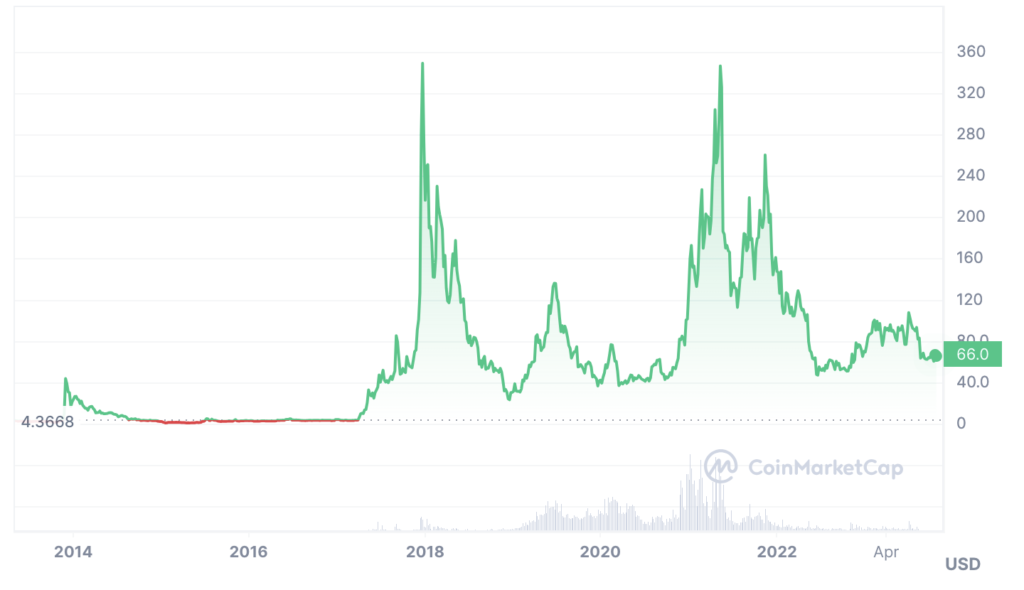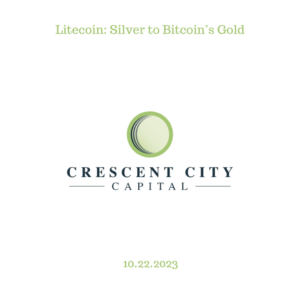Litecoin: Silver to Bitcoin’s Gold
By Rayna Ishihara | Crescent City Capital Market Analyst Intern
What is Litecoin

Litecoin (LTC) was introduced in 2011 as a peer-to-peer cryptocurrency, created by Charlie Lee, a former Google employee. Built upon Bitcoin’s original source code, Litecoin aimed to facilitate cheaper and faster transactions compared to Bitcoin, which was more commonly used as a long-term store of value. It operates on a blockchain, ensuring secure and direct fund transfers without the need for intermediaries or centralized authorities. Its design prioritizes efficiency for everyday transactions, with a larger coin limit market cap and a faster mining process, resulting in quicker and more cost-effective transactions, albeit typically smaller in scale.
Mining in Litecoin, similar to Bitcoin, employs ASIC miners to verify and record transaction data within blocks on the blockchain. Despite initial efforts to deter the dominance of large-scale mining firms, these entities swiftly adapted, leading to an increase in their mining capacity. However, Litecoin’s vision of decentralization remains a fundamental principle, achieved through its unique encryption method and the distributed nature of the blockchain, allowing any participant to access and verify the network’s transaction history. Its resilience as a digital currency lies in its ability to provide an alternative payment system, reinforcing its position as one of the top cryptocurrencies globally.
While Litecoin and Bitcoin share fundamental similarities, such as their decentralized nature and blockchain foundation, Litecoin distinguishes itself through its specific focus on everyday transactions. With faster confirmation times and lower transaction costs, Litecoin continues to offer a practical and efficient alternative for peer-to-peer transactions. Charlie Lee’s vision of creating a cryptocurrency accessible for daily use has positioned Litecoin as a significant player in the crypto market, highlighting its resilience and adaptability over the years.
How Litecoin works
Litecoin operates similarly to Bitcoin, using the proof-of-work (PoW) algorithm where miners solve complex mathematical problems to validate transactions and earn rewards. However, it differentiates itself through the use of the scrypt PoW algorithm, which demands more memory than Bitcoin’s SHA-256 algorithm. This approach was designed by its creator, Charlie Lee, to make large-scale, specialized hardware attacks more challenging, aiming to discourage centralization and promote wider participation in the mining process.
With a capped supply of 84 million coins and regular halving events occurring every 840,000 transactions, Litecoin aims to control its inflation rate and ensure scarcity over time. The halving process reduces the miner reward for each new block added to the blockchain, with the current reward standing at 12.5 LTC. This mechanism helps maintain a balance between mining incentives and the total supply of Litecoin, preventing unlimited inflation and ensuring the scarcity of the cryptocurrency.
Furthermore, Litecoin has integrated the Lightning Network, a second-layer technology that facilitates faster and more scalable transactions through micropayment channels. Its implementation serves as a testing ground for similar innovations on the Bitcoin blockchain. This integration, initiated in 2018, enhances the overall efficiency of the Litecoin network, particularly during periods of high congestion and increased transaction fees on the Bitcoin blockchain.
Lite coin and Bitcoin
Litecoin and Bitcoin differ in their maximum supply caps, with Bitcoin set at 21 million and Litecoin at 84 million. Another notable contrast is their mining protocols, with Bitcoin utilizing SHA-256 and Litecoin employing a modified version of Scrypt. This distinction impacts transaction processing times, with Litecoin’s four times faster confirmation rate compared to Bitcoin, though it may compromise some security due to fewer rounds of transaction verification.
Initially positioned as the “silver” to Bitcoin’s “gold,” Litecoin functions as a decentralized, open-source global payment network, addressing some of Bitcoin’s perceived limitations. Its key advantages include faster block generation (1 new block every 2.5 minutes compared to Bitcoin’s 10) and a more accessible coin limit, making it appealing for swift transactions and ease of acquisition. However, the scrypt-based proof-of-work algorithm demands more processing power, affecting the hardware requirements for mining operations, such as ASIC miners and GPU mining rigs.
Despite ranking within the top 15 largest cryptocurrencies by market capitalization, Litecoin’s circulation remains considerably below that of Bitcoin, with over 73 million coins in circulation as of October 2023.
Litecoin Token
Litecoin (LTC) serves as a decentralized digital currency enabling secure and cost-effective global transactions without the risk of censorship. Its accessibility allows users worldwide to utilize the LTC token for various transactions and settlements. Being one of the earliest alternative cryptocurrencies and a significant offshoot of Bitcoin, LTC is widely recognized and actively traded on various leading cryptocurrency exchanges. Additionally, it holds a prominent position among other digital currencies, supporting transactions for goods and services within its network.
Recent updates

The live LTC price on October 22nd is $66.03 USD with a 24-hour trading volume of $296,756,128 USD. It has a circulating supply of 73,791,133 LTC tokens.
The price of Litecoin has increased by 6.13% in the past 7 days, and increased by 1.36% in the past months. Litecoin is 84.55% below the all time high of $412.96.
Analysis:
Since its inception, Litecoin has consistently introduced features to enhance transaction speed while maintaining network security. Its latest endeavor, the integration of MimbleWimble, a privacy protocol designed to encrypt transaction details, aims to improve scalability by reducing block size. Spearheaded by Charlie Lee since 2019, the ongoing development of MimbleWimble is a testament to Litecoin’s commitment to technological innovation and advancement.
Despite not currently leading the cryptocurrency market, Litecoin remains a promising investment option. Its active community support, widespread availability on trading platforms, and a nine-year track record of secure blockchain operation contribute to its credibility. Notably, Litecoin’s lower transaction fees, driven by its inherently faster and more cost-effective transaction processing compared to Bitcoin, further solidify its position. The human element introduced by its creator, Charlie Lee, also adds to the project’s credibility and seriousness.
However, Bitcoin is always Litecoin’s serious competitor. Also, In 2017, the creator of Litecoin, Charles Lee, sold a significant portion of his Litecoin holdings, citing a “conflict of interest.” This move led to a decline in investor confidence and raised concerns about the cryptocurrency’s future trajectory. As a result, It’s always better to not prioritize Litecoin in your portfolio.
From a market perspective, historically, the occurrence of Litecoin Halving events has notably impacted the price of LTC.
For example, the Litecoin Halving event on August 5 2019, drove the price of LTC to a short term high of $141.23 in the end of June,2019.
Likewise, the most recent Halving event on August 2, 2023 also drove the price of LTC to a value of $113 on July 2nd.
As a result, in the long term, we would expect the price surge again in 2027,which is the next LTC Halving time.
From the technical point of view, last week, the price of Litecoin stood at 61.76$, indicating a 6.80% increase over the week, with the current price at $65.97. The recent surge observed this week and the subsequent short-term increasing trend can be attributed to the token’s ability to find support and resistance levels, leading to a subsequent rebound and pushback.
Provided below is a chart displaying the most recent support and resistance lines.
The observed resistance line on the chart appears to be approximately $68.70, while the support line is situated around $59.54. Over the past few months, LTC has repeatedly tested the resistance line from August to October but has consistently retreated, unable to breach the barrier and establish a new price level. Notably, on October 19th, LTC briefly touched the support line at a price level of $59.61, leading to a subsequent price rebound that has significantly contributed to this week’s surge.
Currently, the price is at $65.88, and from a technical perspective, there is a possibility of a slight further increase. This anticipation is grounded in the repeated attempts to surpass the resistance line. With the current price level below the resistance line, it is plausible that there might be another uptick, potentially leading to a breakthrough, propelling the price of LTC to a new threshold.
Summary:
Litecoin, often referred to as the silver to Bitcoin’s gold, is a peer-to-peer cryptocurrency that was created by Charlie Lee in 2011. It is based on the Bitcoin protocol but with some key differences. Like Bitcoin, it enables instant, near-zero cost payments to anyone in the world. However, it boasts faster transaction confirmation times and improved storage efficiency compared to Bitcoin. Its blockchain is capable of handling higher transaction volume.
Litecoin has gained popularity among users and merchants for its efficient transaction processing and its position as one of the early altcoins. It has been considered a reliable alternative for transferring funds globally and has established itself as one of the leading cryptocurrencies in terms of market capitalization. Its active development community continues to work on improvements and integrations to enhance its usability and scalability.
Overall, Litecoin serves as a valuable digital currency that aims to provide fast, secure, and low-cost transactions, making it a viable option for various use cases in the world of decentralized finance and online transactions.
References
https://www.tradingview.com/chart/zrsQqqcn/?symbol=COINBASE%3ALTCUSD
https://cointelegraph.com/learn/what-is-litecoin-a-beginners-guide-to-ltc-and-how-it-works
https://www.investopedia.com/articles/investing/040515/what-litecoin-and-how-does-it-work.asp
https://coinmarketcap.com/currencies/litecoin/
https://www.investopedia.com/terms/l/litecoin.asp

